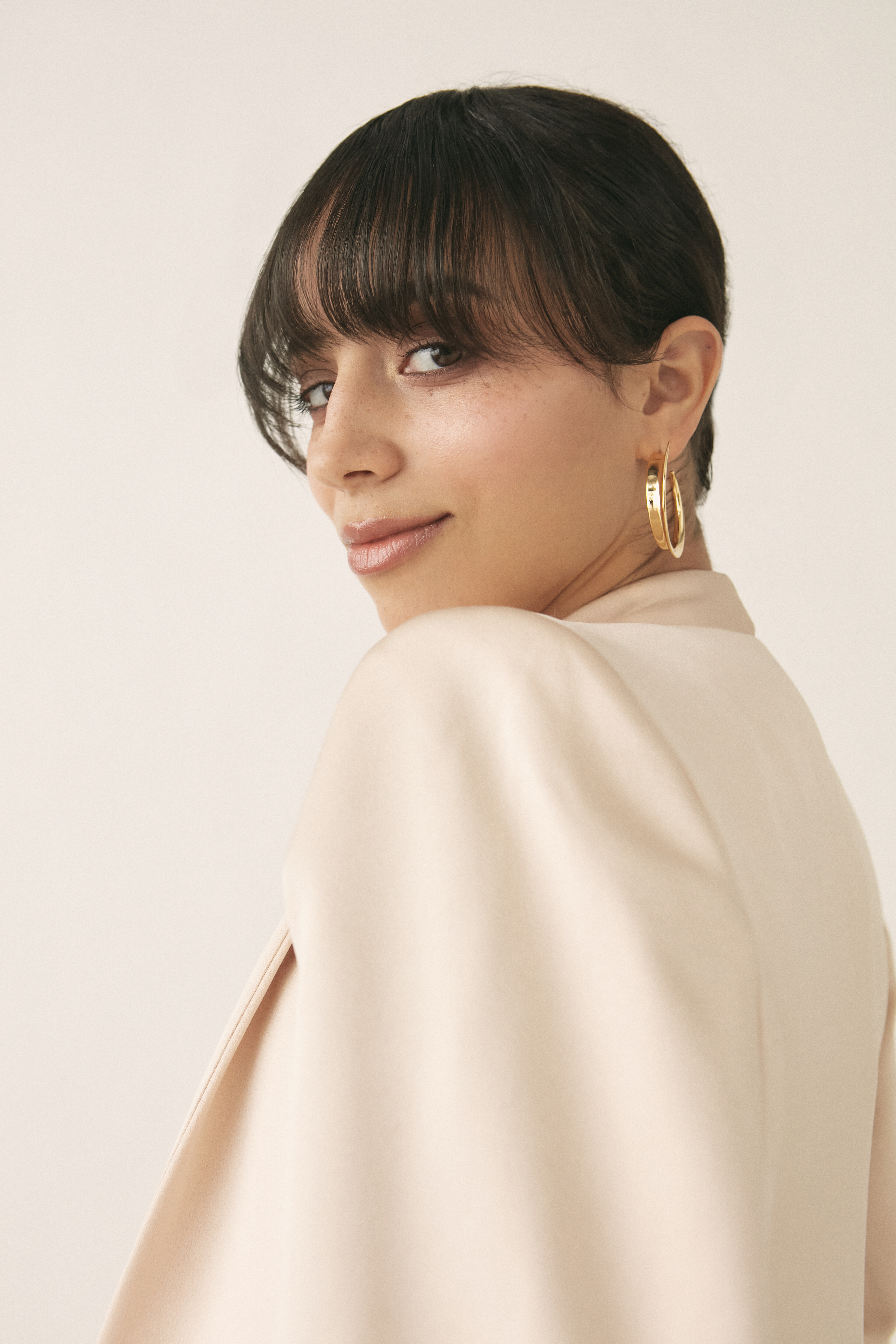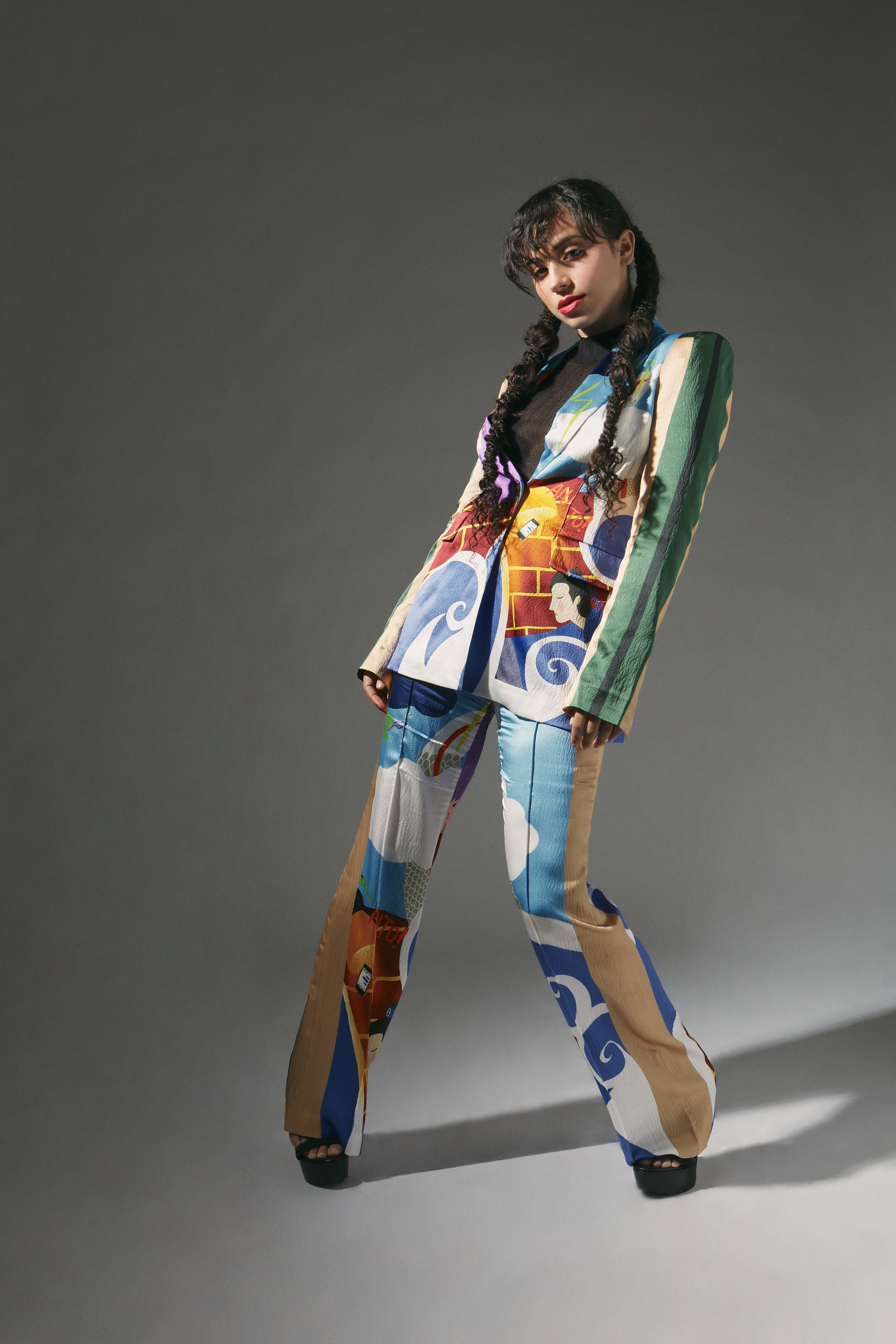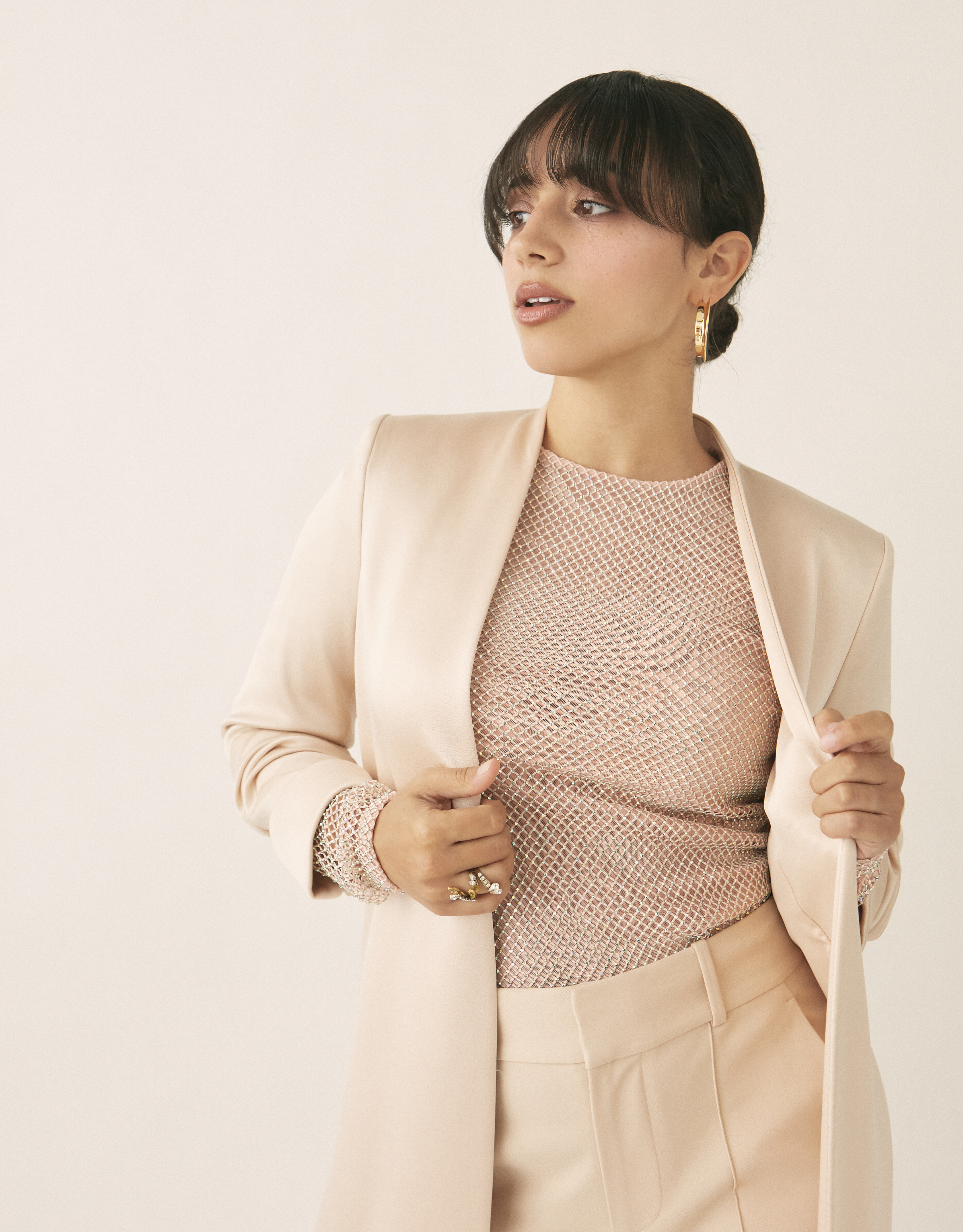
When watching Kiana Madeira battle undead serial killers onscreen, it’s hard to believe the actress hasn’t been a horror movie heroine for years. In fact, her first lead role in the genre is Deena, a headstrong high school student who serves as the protagonist for Netflix’s new Fear Street trilogy.
Based on R.L. Stine’s chilling novels of the same name, Fear Street follows a group of teens in 1994 as they battle evil forces plaguing their hometown of Shadyside. When Deena’s love interest Sam falls under a centuries-old curse, the group must retrace Shadyside’s past in 1978 and 1666 to find a cure. Of course, they do this while fighting the town’s undead legions of mass murderers. Originally filmed in 2019, the trilogy has finally been released on Netflix over the last three weeks—and contains numerous references to terrifying flicks like Halloween, Friday the 13th, and Scream (fans of the genre will instantly recognize 1994‘s opening with Maya Hawke as an homage to Drew Barrymore’s iconic Scream performance).

Unlike the “final girls” of those movies, Madeira is in a league of her own when it comes to Fear Street. Not only does the Canadian star take on two different roles for the series, but her primary character, Deena, is both queer and a woman of color. Add a love story as the central force of the trilogy’s plot, and you’ve got three films that are both humane and deeply emotional—with plenty of slasher elements like gory deaths and spine-tingling jump scares.
As the trilogy wraps this weekend with Fear Street Part Three: 1666, GRAZIA sat down with Madeira to discuss her lead performance, the importance of representation in the horror genre, and what scares her the most.
GRAZIA: Congratulations on your leading role in Fear Street! The trilogy is already hyped to be one of the biggest releases this summer. How does it feel for them to finally be out, two years after filming?
Kiana Madeira: Honestly, I feel like it’s such a blessing, because there was so much excitement in 2019 when we were filming the movies. And so, to have that excitement in 2019, and then just have a total revamp of energy and excitement in 2021…I feel like it’s been such a rollercoaster, and it just feels so nice. I’m so grateful that the movies are out now, and in the last two years there’s been a lot of anticipation—so it’s been so beautiful to see how the audience has responded, and getting to engage with them online has been really nice.
G: What’s the reception to Fear Street been like so far, and how do you feel audiences are responding to the two films that have already come out?
KM: I think the audiences have been responding really well, in my opinion. I mean, it seems like everyone is really excited about the cast, and about seeing new actors. I think a fair amount of the actors in the trilogy are not well-known yet, so this is a really good breakout project for all of us. I think the audience is really excited to see some fresh faces. It’s been really cool because I can see people’s responses to, first of all, Part One, and then Part Two coming out. It’s funny, because I know how the trilogy ends, but based off of everyone’s reactions and theories and everything, I’m just thinking to myself, “You guys have no idea what’s to come.” So, it’s been pretty funny having a week in between each movie, and just reading everyone’s responses to each film, and just thinking to myself, “There’s still so much to be revealed.” So, I’m so excited for everyone to see them.
G: We know you’ve been in a few horror productions before, but this was your first role as a protagonist in an entire film series. What was your experience like playing Deena?
KM: It’s been so rewarding, in so many ways. Deena’s such a dynamic character. I mean, she’s strong, and resilient, and determined, and at the same time she’s vulnerable. She feels so many emotions, and as an actor that’s just a dream character to play. Not to mention the fact that I play a different character in Fear Street Part Three: 1666, so that’s another reason why this project has been so rewarding for me as an artist—because I get to tell this story of Deena, and then travel back in time and tell a different side of the story. I think everything kind of came full-circle for me as a creative, and for the project as a whole, so I just felt so fulfilled when we wrapped the project, and now it’s just a different kind of fulfillment, seeing everyone get to absorb all the heart that went into making these movies. It was such a blessing. I love both characters that I play.

G: These films have a lot of intense scenes—you’re constantly on the run from, and fighting, undead serial killers. Were those moments as nail-biting as they looked onscreen?
KM: Yes, they were! [Laughs] The killers in the films, they were performed by stunt performers who are absolutely amazing at what they do. So, they just brought their physicality, their performances were so creepy, and when we were filming them on the day, there were so many moments where I was genuinely scared because everything about being on set really added to everything making it feel real. So, in those moments where…especially in Part One: 1994, where we’re in the hallway and we’re trapping the killers in the bathroom. In that scene where the killers are approaching us and they have to walk right past us to go into the bathroom, I remember when we were filming that I was like, “This is genuinely scary.” So, because the stunt performers were so amazing, it really helped us as actors—it made our job so much easier, because we have Nightwing with the axe, and he’s just huge with the lumberjack jacket, and he’s so fast. And then, Skull Mask is really stealthy in the way that he moves, and then Ruby Lane, who’s smaller but she’s so stealthy and smooth, and kind of lures you in. So, I think everyone did such a good job at portraying those killers that it was pretty scary to film those scenes.
G: Let’s talk horror! Fear Street is based on R.L. Stine’s series of books by the same name. Were you familiar with the books before filming as Deena, or did you read them to prepare for the role?
KM: Before diving into Deena, I wasn’t familiar with the Fear Street books, but I did grow up reading the Goosebumps books. So, I was familiar with R.L. Stine and his amazing ability to tell stories — especially in the horror genre—which really helps, I think. It really gave us permission to use our imagination, just like R.L. Stine does. I think these movies are cool because although they’re based in Shadyside — which is a town that is found in the Fear Street books—they’re not actually based on any specific books. So, I didn’t read any books to prepare for Deena, but I did find that being familiar with R.L. Stine’s work helped.
G: You said you grew up reading Goosebumps, and now you’re acting in a movie series based on another horror series written by R.L. Stine. Was that a full-circle moment for you?
KM: Oh, definitely. R.L. Stine actually came to set when we were filming Part Three: 1666, so I got to meet him, and it was so amazing. Even now, we’ve done some press with him as well, and every time we see him we’re just like, “You are iconic! You’re just incredible.” And he’s still writing books, and they’re still so good—so, he’s pretty legendary in the horror genre.

G: We’d love to hear about your relationship with horror films. Are you a horror fan, and do you have any favorite movies in the genre?
KM: I do love horror! I love being scared. I love the feel, in general, but there’s something about horror that…those jump scares, they really just take you out of your body—which is terrifying, but at the same time oddly enjoyable. My favorite horror film is Get Out. I really love what Jordan Peele did with that, and how it’s layered with social commentary, very similar to the Fear Street trilogy. Other than Get Out, I would say in terms of classics, I really love the original Scream, the 1996 one. I love that it was so self-aware, and it was really funny and clever—and I think that there’s also so many things about Fear Street that kind of pay homage to the original Scream. So, those two are probably my top two.
G: Deena is similar to “scream queen” characters as a female protagonist battling darker forces, but she’s not your traditional horror protagonist. How do you think she differs from the stereotype of that historical role?
KM: I think Deena has similarities to “final girls” in horror films that we’ve seen traditionally, because she’s strong, and she’s determined, and she’s passionate. Although, like you said, I do think there’s so many ways that she’s different, and it’s really refreshing to see—the top two being that she’s a woman of color, and that she’s a queer woman. The combination of those two are so rare to see onscreen in general, and especially in genre films such as horror. She’s so different, and that’s what’s so beautiful about these films. They really shine a light on people who have been considered to be misfits. They shine a light on those characters, and put them at the front and center, and make them the heroes of the story. So, I think that’s really refreshing, and I hope that the genre and the industry continues to move in that direction.
G: Fear Street is a horror trilogy, of course, but it has a really emotional love story that’s central to the plot—which isn’t common in that genre. And it’s LGBTQ+, no less! What does it mean to you to be a part of this new type of horror dynamic, and what’s the response been like from viewers?
KM: Honestly, I’m so grateful to be a part of a film trilogy that’s so groundbreaking in that way. The response from viewers has been so encouraging, which we expected because I think that these movies really reflect the world that we’re living in today—and I think that audiences today can really see themselves onscreen in every character that’s in the Fear Street trilogy. So, the response has been so encouraging. People have said things like, “It’s about time,” and it’s been really positive. I’m really happy about that.
G: Did filming Fear Street make you want to do more horror projects in the future—and when can we expect to see you on our TV or movie theater screens next?
KM: I love horror [films]. They are very physically, emotionally, and mentally demanding. But, as an actor, I really do love being challenged. The one thing about horror that I will say is I lose my voice really easily, so I don’t know if it’d be a great idea for me to just continue only doing horror. I think I would like to do something a little different for my next project, but don’t get me wrong; I would definitely still love to do horror in the future. As for my next project, you can see me in After We Fell, which is hitting theaters in the fall. I play a character named Nora, and it’s a part of the After franchise, so I’m excited for people to see that movie.
G: Finally, we have to ask—what scares you the most?
KM: That’s a great question. What scares me the most? It’s funny, this was never a fear of mine before, but lately I’m finding escalators are really scary—especially really tall escalators. There’s one specific escalator that comes to mind in New York, at 76th Street, at the subway, and it’s just so scary. I feel anxiety stepping on, stepping off, as it gets to the top I get scared looking down. So, I don’t know if that means I’m afraid of heights. I’ll have to see and test it out in different scenarios—but I think I’m developing a fear of escalators.













